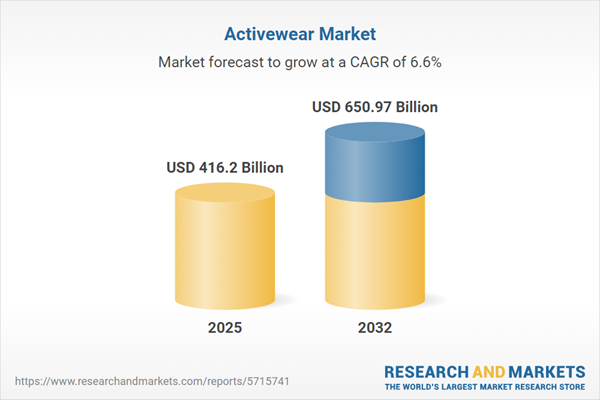Speak directly to the analyst to clarify any post sales queries you may have.
The global activewear market is undergoing a significant transformation, driven by organizational responses to digital disruption, regulatory shifts, and changes in consumer expectations. Senior decision-makers must adapt strategies that foster innovation, enhance sustainability, and ensure operational flexibility to maintain competitiveness in an evolving environment.
Activewear Market Snapshot
The global activewear market reached a valuation of USD 390.37 billion in 2024 and is set to grow to USD 416.20 billion by 2025. With a projected compound annual growth rate (CAGR) of 6.60% through 2032, the market may attain USD 650.97 billion. This upward trajectory is supported by increasing demand for sustainable products, broader adoption of digital shopping channels, and the continuous evolution of consumer purchasing behaviors. Market leaders respond by diversifying their portfolios, adopting omnichannel strategies, and tailoring product offerings to diverse market needs and demographic groups.
Scope & Segmentation in the Activewear Market
This report provides structured frameworks for executive teams to design targeted strategies and allocate resources effectively. Comprehensive segmentation offers deeper insight into the competitive landscape and enables focused opportunity mapping across the value chain. The main segmentation elements include:
- Product Types: Performance accessories, a broad selection of bottoms, outerwear, sports bras, and multi-use tops, enabling precise decisions from inventory management to merchandising strategy.
- Distribution Channels: Physical retail stores such as department and sports outlets, along with brand websites and major online platforms, to align sales tactics with evolving purchasing habits and meaningful sales analytics.
- Gender Segmentation: Men’s, women’s, and unisex collections that allow for refined targeting and development of unique branding initiatives, tracking consumer motivation by gender.
- Age Groups: Adult, teen, and children’s lines for message customization and enhanced product features, aligning with diverse lifestyle and performance requirements.
- Pricing Tiers: Mass-market, premium, and luxury offerings, which enable strategic benchmarking, margin optimization, and differentiation across consumer groups.
- Materials: Use of cotton, nylon, polyester blends, and innovative sustainable fabrics, underlining material advances as a driver for operational resilience and sustainability positioning.
- Regions: Focus on the Americas, Europe, Middle East & Africa, and Asia-Pacific, equipping teams with intelligence for tailored regional go-to-market approaches and recognizing market maturity.
- Companies Analyzed: Benchmarks include Nike, adidas, Anta Sports, PUMA, Lululemon, Under Armour, ASICS, VF Corporation, Columbia Sportswear, and Fila Holdings, supporting evaluation of collaborations, competitive landscape, and future planning.
Key Takeaways for Senior Decision-Makers
- Integrating sustainability within global activewear supply chains is now a baseline requirement, advancing brand reputation and compliance with increasing environmental expectations.
- The adoption of artificial intelligence enables improved personalization and digital experiences, such as virtual fittings, which are elevating consumer engagement and loyalty.
- The blending of activewear and casual wear addresses shifting lifestyle needs and deepens long-term consumer relationships through product versatility.
- Direct-to-consumer models increase the speed of product feedback cycles and support timely adjustments, allowing firms to respond rapidly to changing market demands.
- Addressing regional differences in digital readiness and consumer preferences is essential for scaling market strategies and optimizing resource deployment.
- Collaboration in material innovation and forming strategic alliances in distribution strengthen product differentiation and support managed risk as companies expand into new territories and segments.
Tariff Impact
Forthcoming U.S. tariffs on synthetic materials and finished activewear, effective in 2025, require brands to re-examine their supply chain models. Leading companies are diversifying suppliers, increasing nearshoring efforts, and updating pricing structures to safeguard margins. Scenario analysis and robust financial planning support risk mitigation and adaptiveness to new regulatory demands.
Methodology & Data Sources
This research is based on executive interviews, thorough consumer surveys, noted industry publications, official databases, and trade association reports. Subject matter experts review all insights, providing relevant and trustworthy information for senior leaders in the activewear industry.
Why This Report Matters
- Offers clear benchmarks for adapting to changing consumer values and priorities, making it easier to identify technology investments and channel shifts for greater adaptability.
- Equips executives with actionable segmentation frameworks and detailed regional data to elevate partnership strategies and execution in the activewear market.
- Delivers proactive guidance for navigating technological and regulatory complexity, supporting sustainable business advancement.
Conclusion
Organizations that prioritize sustainable practices, adopt digital innovation, and develop regionally adaptive strategies will be best positioned for lasting success in the dynamic activewear market.
Additional Product Information:
- Purchase of this report includes 1 year online access with quarterly updates.
- This report can be updated on request. Please contact our Customer Experience team using the Ask a Question widget on our website.
Table of Contents
3. Executive Summary
4. Market Overview
7. Cumulative Impact of Artificial Intelligence 2025
List of Figures
Samples

LOADING...
Companies Mentioned
The key companies profiled in this Activewear market report include:- Nike, Inc.
- adidas AG
- Anta Sports Products Limited
- PUMA SE
- Lululemon Athletica Inc.
- Under Armour, Inc.
- ASICS Corporation
- VF Corporation
- Columbia Sportswear Company
- Fila Holdings Corp
Table Information
| Report Attribute | Details |
|---|---|
| No. of Pages | 181 |
| Published | October 2025 |
| Forecast Period | 2025 - 2032 |
| Estimated Market Value ( USD | $ 416.2 Billion |
| Forecasted Market Value ( USD | $ 650.97 Billion |
| Compound Annual Growth Rate | 6.6% |
| Regions Covered | Global |
| No. of Companies Mentioned | 11 |









